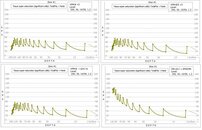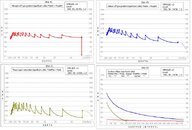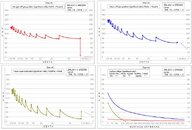. I have a scientific background myself and your way of criticising others does not give you credit in this post. Your science looks really financially biased . Sorry to see this. Freewillow, Ph.D.
I have been supplying top quality deco products to the community for 15 years now. I make and sell software for both sides of this argument. You claiming its all about money is plain wrong, and an insult to my integrity. I like to get down to the facts of this tests, because I have an strong interest in this subject. The commentary being offered by others on the Nedu test does not fit with the facts, and we are demonstrating that. I'm sorry that you may find that unusual or unacceptable.
Sadly that process of fitting this Nedu test result into the big picture and giving us some context, seems to have been overlooked. In its place, we have a "leading expert" just making stuff up to fit a position he has been pushing since 2008.
As for the rest of it, the others are correct: it has all been addressed elsewhere. Your peak supersaturation graphs are just a distraction.
Simon M
Are you joking? You might like to re-read the TR 11-06 Nedu report to which you repeatedly refer. The significance of supersaturation is paramount to decompression. From the Introduction by David:
"During subsequent ascent to sea level, the ambient barometric pressure (Pamb) may decrease to a level less than the sum of the partial pressures of all n gases dissolved in a particular tissue. In this state the tissue is gas supersaturated by an amount equal to the difference, Sptisj - Pamb > 0, for j=1, …, n dissolved gases. The gas supersaturated state may be sustained metastably until relieved by physiological washout of gas via the blood and lungs, or may be relieved by in situ formation of bubbles from the excess dissolved gas. The risk of DCS is thought to depend on the size, profusion, and location of such bubbles."
Yes, of course peak supersaturations in fast tissues are higher in shallow stop profiles. But the point you completely fail to grasp, and the one elegantly demonstrated by the NEDU study, is that this does not seem to matter clinically. What appears important (based on the hard outcomes of that study) is the increased integral of supersaturation and time (which your graphs do not show) later in the ascent in the slower tissues that continue to take up gas during deep stops. This principle has been independently demonstrated recently by an increase in DCS rates precipitated simply by longer flights in a low pressure aviation setting.
Simon M
The supersaturation you talk about is almost non-existent in the higher risk profile. See the diagram. The A2 test has the lowest amount of supersaturation, and lowest amount of nonsense mb/mins.
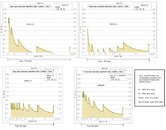
Note: We scaled these graphs to meet this nonsense timed basis mb/min measure. The filled-in area below each graph shows that amount. Note how the highest one is the A1 plan. The lowest is the A2 "high risk" plan. Where is this
"increased integral of supersaturation and time", that you speak of? It ain't there Simon.
These nedu test profiles have been elongated in the shallow stops so much, that supersaturation has been severely reduced. Any normal dive we do today has much higher super saturation levels than these test profiles.
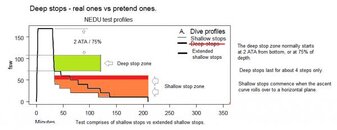
The Nedu test method was one of manipulating shallow stops excessively longer. Strangely, that is the same as your current recommendation - longer shallow sections.
That is the hypocritical aspect of all this:
These test profiles should have been fantastically safe by ZHL / GF standards. They have more than double the shallow stop time needed. They use the same method we apply to all dives to reduce risk - that is: to make it safer, go longer in the shallow parts. But both these test profiles have unusually high injury levels. Is there some kind of reversal in the added safety method? Or has some other outside influence increased the risk?
An astute scientist would see the anomaly here, and seek out other factors to attribute to the cause of injury.
But your "plausible explanation" gives the cause as supersaturation (that's almost non-existent) and from deep stops (that don't exist). Sorry, but your explanations do not pass analysis Simon.




 after dives much deeper than 200' and/or with more than a hour or so of deco hang, unless I put a 70% GFS on top of it. And I know, having been prompted to experiment by commentary and debate, that limiting the % of helium in my algorithm and running 60/85 GFs leave me feeling a heck of a lot better. Others are putting in 0% helium and diving 85/90 and feeling good; still others report great success with straight VPM models in deeper dives and longer hangs than I'm currently doing.
after dives much deeper than 200' and/or with more than a hour or so of deco hang, unless I put a 70% GFS on top of it. And I know, having been prompted to experiment by commentary and debate, that limiting the % of helium in my algorithm and running 60/85 GFs leave me feeling a heck of a lot better. Others are putting in 0% helium and diving 85/90 and feeling good; still others report great success with straight VPM models in deeper dives and longer hangs than I'm currently doing.